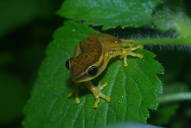|
Feihyla hansenae (Cochran, 1927)
Hansen's Asian Treefrog, Hansen's Bushfrog | family: Rhacophoridae subfamily: Rhacophorinae genus: Feihyla |
 © 2023 Sinlan Poo (1 of 6) |
|
|
|
Distribution and Habitat Country distribution from AmphibiaWeb's database: Thailand
Life History, Abundance, Activity, and Special Behaviors Egg attendance by females serves to protect the eggs from predation as Taksintum et al observed females jumping on the backs of grasshoppers that would eat the eggs (Taksintum et al. 2012). Comments A study on Feihyla hansenae, a rhacophorid treefrog from Thailand with terrestrial eggs, shows that embryos are capable of hatching early to escape flooding, and that failure to hatch results in mortality. By incorporating natural and experimental data into Monte Carlo methods to simulate and compare survival probabilities with and without hatching plasticity, Poo et al. (2023) found an overall increase in submergence survival due to hatching plasticity. As intensity and consistency of rainfall become more unpredictable and more variable due to climate change, there is a clear need for more life history data to increase the accuracy of our predictions on how animals may respond. These results add to the growing body of literature surrounding climate-correlated effects on poorly-studied amphibian populations. (Written by Sinlan Poo)
References
Taksintum, W., Lauhachinda, V & Boonsong, B. 2012. Mating Behavior of Hansen’s Bush Frog (Chiromantis hansenae) at Sakaerat Environmental Research Station, Northeastern Thailand. Kasetsart J. (Nat. Sci.) 46: 862-870. Originally submitted by: Michelle S. Koo (2023-06-11) Distribution by: Michelle S. Koo (updated 2023-06-11)
Life history by: Michelle S. Koo (updated 2023-06-11)
Edited by: Michelle S. Koo (2023-06-11) Species Account Citation: AmphibiaWeb 2023 Feihyla hansenae: Hansen's Asian Treefrog <https://amphibiaweb.org/species/4368> University of California, Berkeley, CA, USA. Accessed May 13, 2025.
Feedback or comments about this page.
Citation: AmphibiaWeb. 2025. <https://amphibiaweb.org> University of California, Berkeley, CA, USA. Accessed 13 May 2025. AmphibiaWeb's policy on data use. |



 Map of Life
Map of Life